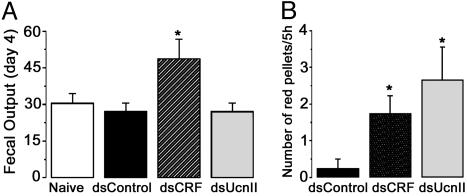Fig. 2.
CRF and UcnII inhibition modulate intestinal motility. (A) Inhibition of CRF, and not UcnII, results in cumulative increase in fecal output over 24 h. Fecal pellets were counted daily for up to 4 days after dsRNA treatment. In contrast to CRF, UcnII displays circadian rhythm in exerting effects on ileal motility. (B) Assessment of the number of times red mucus or red-tinted pellets were expelled within a 5-h time frame (soon after lights on and just before the circadian rise in endogenous corticosteroid levels) indicates that ileal motility is enhanced by inhibition of both CRF and UcnII in this period.

